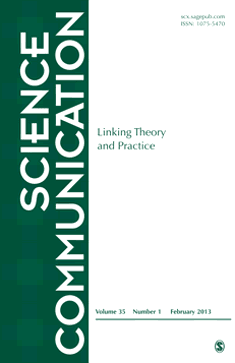
SCIENCE COMMUNICATION
Scope & Guideline
Bridging the Gap: Where Science Meets Communication
Introduction
Aims and Scopes
- Interdisciplinary Approaches to Science Communication:
The journal encourages submissions that adopt interdisciplinary perspectives, integrating insights from fields such as sociology, psychology, education, and communication studies to enrich the discourse on science communication. - Impact of Media on Public Perception of Science:
Research focusing on how various media forms influence public perceptions of scientific issues, including misinformation, media framing, and the role of social media platforms in shaping public discourse. - Science Education and Literacy:
Studies that explore effective strategies for teaching science, enhancing scientific literacy, and fostering critical thinking skills among diverse audiences, particularly in educational settings. - Policy and Governance in Science:
Articles that analyze the intersection of science communication with public policy, governance, and ethical considerations, particularly in the context of emerging technologies and public health crises. - Cultural and Social Dimensions of Science:
Exploration of how cultural, social, and contextual factors shape the communication and understanding of scientific knowledge, including the role of identity, community engagement, and participatory approaches.
Trending and Emerging
- Engagement with Diverse Audiences:
There is a growing emphasis on strategies that effectively engage diverse audiences, including marginalized communities, youth, and non-experts, to democratize science communication and make it more inclusive. - The Role of Digital Media and Technology:
Research focusing on the impact of digital media and technology on science communication practices is increasing, exploring how platforms like social media, podcasts, and virtual reality can enhance public engagement. - Addressing Misinformation and Disinformation:
As misinformation becomes a critical concern, there is a surge in studies aimed at understanding its dynamics and developing strategies to combat it through effective science communication. - Participatory and Community-Based Approaches:
There is a significant trend towards participatory science communication methods that involve communities in the research process, fostering co-production of knowledge and enhancing public trust in science. - Interdisciplinary Collaboration:
The journal is increasingly publishing works that highlight the importance of interdisciplinary collaboration in science communication, integrating insights from social sciences, humanities, and technology studies to address complex scientific issues.
Declining or Waning
- Traditional Science Communication Models:
There has been a noticeable decline in research focused on traditional models of science communication that emphasize a one-way transmission of information from scientists to the public, as newer, more participatory models gain traction. - Narrow Focus on Specific Scientific Disciplines:
Papers that concentrate exclusively on specific scientific disciplines without considering interdisciplinary contexts or broader societal implications are becoming less frequent, indicating a shift towards more holistic approaches. - Static Communication Strategies:
The exploration of static communication strategies, such as simple informational pamphlets or lectures, is waning as the field increasingly prioritizes dynamic, interactive, and engaging methods of communication. - Overemphasis on Negative Framing of Science Issues:
Research focusing predominantly on negative aspects of science communication, such as public distrust or backlash against science, is decreasing, suggesting a shift towards more constructive and solution-oriented narratives. - Limited Engagement with Emerging Technologies:
Research examining the role of emerging technologies (e.g., AI, VR) in science communication has not been as prevalent, indicating a potential area that requires more attention in future studies.
Similar Journals
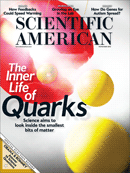
SCIENTIFIC AMERICAN
Exploring the Frontiers of Scientific UnderstandingSCIENTIFIC AMERICAN, published by Springer, stands as a prestigious multidisciplinary journal dedicated to disseminating cutting-edge scientific knowledge across a range of fields. Established in 1947, this journal has been integral in bridging the gap between scientific research and public understanding, making complex ideas accessible to a broader audience. With an ISSN of 0036-8733 and E-ISSN of 1946-7087, it maintains a strong standing within the academic community, currently ranked in the Q3 category for its multidisciplinarity, and is positioned at #93 out of 120 in its Scopus ranking, reflecting its valuable contribution to scientific discourse. While the journal is not open access, its long history and commitment to knowledge sharing ensure it remains a vital resource for researchers, professionals, and students alike, fostering a deeper appreciation of science in society.

SCIENCE AS CULTURE
Advancing Understanding of Science's Role in Cultural ContextsSCIENCE AS CULTURE is a distinguished journal published by Routledge Journals, Taylor & Francis Ltd, focusing on the interdisciplinary intersections of science and culture since its inception in 1987. With an ISSN of 0950-5431 and an E-ISSN of 1470-1189, the journal has established a strong reputation in various academic fields, most notably holding Q1 rankings in Cultural Studies, Health (Social Science), History and Philosophy of Science, and Sociology and Political Science. The journal aims to provide a platform for innovative research that critically examines the social, cultural, and political dimensions of scientific practices and knowledge. Despite not being an Open Access publication, it remains accessible to a wide audience, bolstered by its impressive impact factor and the rigorous peer-review process that ensures the quality of published articles. As a key resource for researchers, professionals, and students alike, SCIENCE AS CULTURE invites contributions that challenge traditional perspectives and stimulate dialogue across the sciences and humanities.
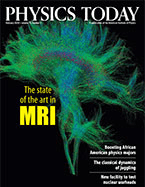
PHYSICS TODAY
Connecting Innovators in Physics and AstronomyPHYSICS TODAY is a prestigious journal published by the American Institute of Physics, serving as a pivotal platform for the dissemination of innovative research and developments in the field of physics and astronomy. With an ISSN of 0031-9228 and an E-ISSN of 1945-0699, this journal has been in circulation since 1948 and is set to continue until 2024. Recognized for its substantial contributions to the scientific community, PHYSICS TODAY holds a significant position within the Q2 quartile of the Physics and Astronomy category as of 2023. Although it does not offer open access, its articles remain crucial resources for researchers, professionals, and students seeking to stay abreast of the latest advancements across a broad range of topics in general physics and astronomy. With a current Scopus ranking of #150 out of 243 and a percentile standing at 38, the journal bolsters its reputation as a reliable source for high-quality scientific discourse. In an era of rapid scientific advancement, PHYSICS TODAY remains dedicated to fostering a deeper understanding of the physical universe, making it an essential read for those invested in the future of physics.
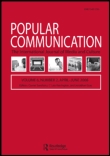
Popular Communication
Advancing Scholarship in Popular CommunicationPopular Communication, published by Routledge Journals, Taylor & Francis Ltd, is a leading academic journal in the field of Communication, recognized for its Q1 ranking in the 2023 Scopus category. With an ISSN of 1540-5702 and an E-ISSN of 1540-5710, this journal has been converging significant research from 2010 to 2024, highlighting contemporary trends and evolving dynamics in popular communication practices. The journal is based in the United Kingdom and focuses on the intersection of media, culture, and communication, making it a vital resource for researchers, professionals, and students interested in understanding the impact of communication in society today. Although it does not offer Open Access options, it remains a cornerstone for scholarly discourse, with an impressive rank of #96 out of 511 in Social Sciences Communication, placing it in the 81st percentile. Contributions to this journal play a critical role in advancing knowledge and encouraging further scholarship in the diverse realm of popular communication.

International Journal of Communication
Championing high-quality research in communication.International Journal of Communication, published by USC Annenberg Press, is a premier open access journal dedicated to advancing the field of communication studies. Since its inception in 2007, the journal has provided a vital platform for researchers, professionals, and students to engage with cutting-edge research, theoretical frameworks, and empirical studies. With an impressive Q1 quartile ranking in Communication for 2023 and a notable Scopus rank of 156 out of 511 in the Social Sciences Communication category, the journal consistently contributes to high-quality scholarly discourse. It covers a wide array of topics, making it a crucial resource for those looking to stay informed about the latest developments in communication research. The journal's commitment to open access enhances its reach and impact, fostering a global community of academics and practitioners dedicated to exploring the complexities of communication in contemporary society. This makes the International Journal of Communication an essential read for anyone interested in understanding the dynamics of communication today.
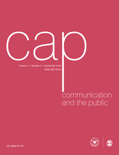
Communication and the Public
Transforming communication studies into public action and awareness.Communication and the Public is an esteemed journal dedicated to advancing the field of communication studies, published by SAGE Publications Ltd. With its focus on the interplay between communication practices and public engagement, the journal serves as a crucial platform for researchers, professionals, and students alike. Established in 2016 and continuing through to 2024, it holds a prestigious Q1 rank in Communication, underscoring its significant contributions to scholarly discourse—evidenced by its solid placement in the Scopus Ranks at 131 out of 511 in the Social Sciences Communication category, positioning it in the top 74th percentile. While it currently operates under a traditional access model, the journal aims to foster open dialogue and disseminate impactful research that shapes public understanding of communication processes. With an ISSN of 2057-0473 and an E-ISSN of 2057-0481, Communication and the Public continues to be an essential resource for those seeking to explore the nuances of communication in public contexts.

Canadian Journal of Communication
Navigating the Complexities of Communication TheoryCanadian Journal of Communication, published by University of Toronto Press Inc., serves as a vital conduit for scholarly discourse within the field of communication studies. With an ISSN of 0705-3657 and an E-ISSN of 1499-6642, this esteemed journal holds a Q2 ranking in the category of Communication according to 2023 metrics, reflecting its commitment to high-quality research and innovation. Located in Canada and covering converged years from 2016 to 2024, the journal provides a comprehensive platform for the exchange of ideas, critical analyses, and theoretical advancements that shape our understanding of communication in contemporary society. Although it does not currently offer open access, the journal’s influence is demonstrated by its position in Scopus, ranking #332 out of 511 in the Social Sciences Communication category. This publication is essential for researchers, professionals, and students seeking to deepen their knowledge in communication contexts and explore the intricate dynamics that define human interaction.
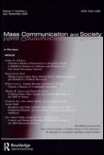
Mass Communication and Society
Pioneering Research in the Evolving Landscape of Mass CommunicationMass Communication and Society is an esteemed journal published by Routledge Journals, Taylor & Francis Ltd, focusing on the dynamic field of communication studies. With its ISSN 1520-5436 and E-ISSN 1532-7825, the journal has established itself as a leading platform for high-quality research since its inception. With a prestigious positioning in the Q1 category of Communication as of 2023, it ranks impressively at #45 out of 511 in Scopus within the social sciences communication sector, boasting a 91st percentile in its field. The journal serves as a vital resource for researchers, professionals, and students interested in emergent issues, theories, and methodologies related to mass communication and its impact on society. Although it does not offer Open Access options, the journal remains committed to advancing scholarly discourse and providing rigorous insights into how communication shapes social dynamics. Since its converged years from 2008 to 2024, Mass Communication and Society continues to push the boundaries of knowledge in a rapidly evolving academic landscape, making it a must-read for anyone invested in the communication discipline.

Metode Science Studies Journal
Cultivating Scholarly Exchange in Multidisciplinary ResearchMetode Science Studies Journal, published by UNIV VALENCIA, BOTANICAL GARDEN UV, is an esteemed open-access journal dedicated to advancing scholarly discourse in the fields of history and philosophy of science and multidisciplinary studies. Since its inception in 2013, the journal has positioned itself as a vital resource for researchers, professionals, and students, fostering an environment for innovative research and cross-disciplinary dialogue. Based in the vibrant city of Valencia, Spain, this journal aims to publish high-quality articles that explore the intricate relationships between scientific practices and philosophical inquiries. With a current impact factor demonstrating its relevance in the academic community, the journal is indexed in Scopus, ranking in the 52nd percentile for history and philosophy of science and the 33rd percentile for multidisciplinary studies. Scholars can access a breadth of research outputs that span from 2015 to 2024, thereby contributing significantly to the intellectual landscape of the respective fields.
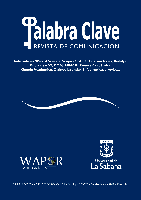
Palabra Clave
Exploring Contemporary Issues with Critical InsightPalabra Clave is a leading open-access journal published by the UNIV SABANA, FAC COMUNICACION in Colombia, dedicated to advancing the fields of Arts and Humanities as well as Communication. Since its inception in 2001, the journal has committed to providing a platform for innovative research and critical discourse, garnering an impressive Q2 classification in both respective fields. The journal is indexed in Scopus, with a commendable ranking of #26 out of 173 in Arts and Humanities, representing the 85th percentile, and #263 out of 511 in the Communication category, indicating its significant impact within the academic community. With its converged years from 2012 to 2024, Palabra Clave encourages scholars, professionals, and students to engage with contemporary issues through a lens of interdisciplinary scholarship. Accessible through its open-access model, this journal fosters the democratization of knowledge and aims to connect researchers across the globe.